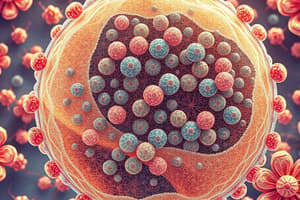Podcast
Questions and Answers
What is the main component of biological membranes?
What is the main component of biological membranes?
- Phospholipids (correct)
- Prostaglandins
- Terpenoids
- Glycosphingolipids
What is the parent compound for glycerol-based phospholipids?
What is the parent compound for glycerol-based phospholipids?
- Phosphatidic acids (correct)
- Sphingolipids
- Glycosphingolipids
- Phosphoglycerides
What is the characteristic feature of phosphoglycerides?
What is the characteristic feature of phosphoglycerides?
- A dihydroxyamine backbone
- A sphingosine backbone
- A galactocerebroside backbone
- A glycerol backbone linked to two fatty acids and phosphoric acid (correct)
What is the function of gangliosides?
What is the function of gangliosides?
What is the precursor of steroid hormones?
What is the precursor of steroid hormones?
What is the characteristic feature of terpenoids?
What is the characteristic feature of terpenoids?
What is the term for the connection of isoprene units in terpenoids?
What is the term for the connection of isoprene units in terpenoids?
What is the function of cyclooxygenase (COX)?
What is the function of cyclooxygenase (COX)?
What is the characteristic feature of steroids?
What is the characteristic feature of steroids?
What is the biosynthetic pathway of steroids?
What is the biosynthetic pathway of steroids?
Flashcards are hidden until you start studying
Study Notes
Lipid Structure of Biological Membranes
- Phospholipids are diesters of phosphoric acid, which can form monoesters, diesters, and triesters.
- Phosphatidic acids are the parent compound for glycerol-based phospholipids, consisting of sn-glycerol-3-phosphate with fatty acids esterified at the 1- and 2-positions.
Phosphoglycerides
- Contain a glycerol backbone linked by ester bonds to two fatty acids and phosphoric acid.
- Fatty acid residues have 12-20 carbon atoms.
- The phosphate group at C3 has an ester link to an amino alcohol.
- Comprise the major lipid component of cell membranes.
- Nonpolar tails aggregate in the center of a bilayer, while the ionic head is exposed to the solvent.
Sphingolipids
- The other major group of phospholipids, containing a sphingosine or dihydroxyamine backbone.
- Constituents of plant and animal cell membranes.
- Abundant in brain and nerve tissue, forming a coating around nerve fibers.
Prostaglandins
- Lipid autacoids derived from arachidonic acid, catalyzed by cyclooxygenase (COX).
- C-20 lipids containing a five-membered ring with two long side chains.
- Present in small amounts in all body tissues and fluids, with many physiological effects.
Glycosphingolipids
- Derivatives of ceramide, lacking in phosphorus and nitrogen base.
- Abundant in the myelin sheath of nerves.
- Galactocerebrosides are present in all adult brains, while glucocerebrosides are present in small amounts in certain pathological conditions and in immature brains.
Gangliosides
- Acidic glycosphingolipids with polar heads that are oligosaccharides with one or more residues of sialic acid (N-acetylneuraminic acid or NANA).
- Found in nerve endings and believed to function in the transmission of nerve impulses.
Terpenoids
- Found in plants and account for the flavor and scents of plant structures (flowers and fruits).
- Chemically related to compounds in turpentine (from pine sap) called terpenes, which are hydrocarbons that do not contain esters.
- Derived from isoprene units connected head-to-tail (Isoprene Rule).
Classification of Terpenoids
- According to the number of di-isoprenoid (C10) units they contain.
- Examples include the triterpene lanosterol, the precursor of steroid hormones, and the tetraterpene beta-carotene, a source of vitamin A.
Steroids
- A class of non-saponifiable lipid, defined by structure, with four fused rings A, B, C, and D.
- Carbon atoms are numbered beginning in the A ring, and the six-membered rings are in fixed chair conformations.
- As hormones, steroids are chemical messengers secreted by glands and carried through the bloodstream to target tissues.
- Widely distributed as cholesterol.
Studying That Suits You
Use AI to generate personalized quizzes and flashcards to suit your learning preferences.




